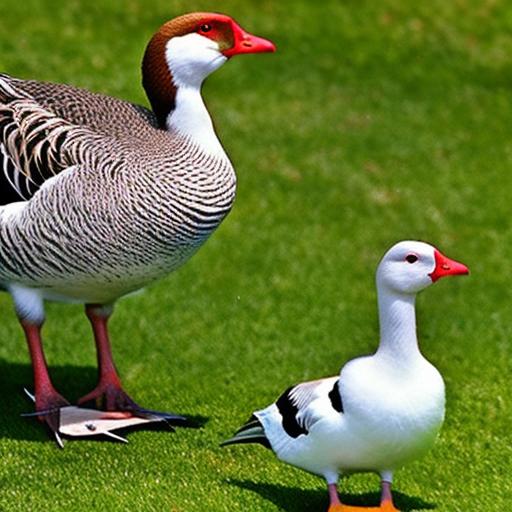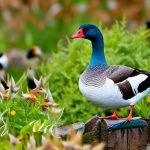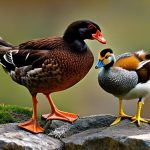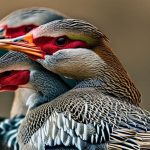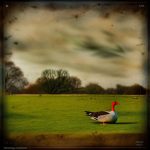Geese can be a beautiful sight to behold, gracefully gliding across a pond or flying in a V-formation overhead. However, when geese become a nuisance, they can cause significant problems. From damaging property to leaving behind droppings that can pose health risks, geese can quickly become a headache for homeowners and property managers alike. Understanding the behavior of geese is crucial in order to effectively manage and deter them from unwanted areas.
Key Takeaways
- Geese are social animals that prefer open spaces near water and grassy areas.
- Natural deterrents for geese include planting certain types of vegetation and using decoys of predators.
- Physical barriers like fences and netting can prevent geese from accessing certain areas.
- Loud noises like sirens and fireworks can scare off geese, as can visual deterrents like reflective tape and balloons.
- Chemical repellents like Methyl Anthranilate can be effective, but should be used with caution.
Understanding the behavior of geese
A. Social behavior of geese
Geese are highly social animals that typically live in large flocks. They form strong pair bonds and are known for their loyalty to their mates and offspring. Geese communicate with each other through honking and body language, and they often exhibit aggressive behavior when they feel threatened or when protecting their nests. Understanding the social dynamics of geese can help in developing effective strategies for managing them.
B. Nesting habits of geese
Geese are known to be territorial when it comes to nesting. They prefer to nest near bodies of water, such as ponds or lakes, where they can easily access food and water. Geese build their nests on the ground, typically using grasses and other vegetation. They are protective of their nests and will aggressively defend them if they feel threatened. Knowing where geese are likely to nest can help in implementing deterrents to prevent them from settling in unwanted areas.
C. Feeding habits of geese
Geese are herbivores and primarily feed on grasses, aquatic plants, and grains. They have a voracious appetite and can quickly deplete vegetation in an area if left unchecked. Geese are attracted to areas with abundant food sources, such as well-maintained lawns or agricultural fields. Understanding their feeding habits can help in implementing strategies to discourage geese from foraging in unwanted areas.
Natural deterrents for geese
A. Planting certain types of vegetation
One natural deterrent for geese is to plant vegetation that they find unappealing. Geese prefer short, well-manicured grass, so allowing taller grasses or native plants to grow can discourage them from settling in an area. Additionally, planting shrubs or trees near bodies of water can create barriers that make it more difficult for geese to access nesting sites.
B. Using decoys
Another natural deterrent for geese is the use of decoys. Geese are highly territorial and will avoid areas where they see other geese. Placing decoys, such as plastic geese or swans, near ponds or other areas where geese are a problem can help deter them from settling in those areas.
C. Allowing natural predators to roam
Geese have natural predators, such as hawks, foxes, and coyotes. Allowing these predators to roam freely can help in managing geese populations. However, it is important to consider the potential risks and benefits of introducing predators into an area, as they may also pose a threat to other wildlife or pets.
Physical barriers to keep geese away
A. Fencing
One effective physical barrier to keep geese away is fencing. Installing a fence around ponds or other areas where geese are a problem can prevent them from accessing those areas. It is important to ensure that the fence is tall enough and has no gaps that geese can squeeze through.
B. Netting
Netting can also be used as a physical barrier to keep geese away. Placing netting over bodies of water or other areas where geese are a problem can prevent them from landing or accessing those areas. However, it is important to regularly check and maintain the netting to ensure that it remains effective.
C. Spikes
Spikes can be installed on ledges or other areas where geese like to perch or roost. The spikes make it uncomfortable for geese to land or stay in those areas, encouraging them to move on to more suitable locations.
Using sound to scare off geese
A. Loud noises
Geese are sensitive to loud noises and can be scared away by sudden loud sounds. Using devices that emit loud noises, such as air horns or propane cannons, can help in deterring geese from settling in unwanted areas. However, it is important to consider the potential impact on other wildlife or nearby residents when using these methods.
B. Ultrasonic devices
Ultrasonic devices emit high-frequency sounds that are not audible to humans but can be irritating to geese. These devices can be placed near ponds or other areas where geese are a problem to deter them from settling in those areas.
C. Water sprayers
Geese are also sensitive to water and can be scared away by water sprayers. Installing motion-activated sprinklers or water jets near ponds or other areas where geese are a problem can help in deterring them from settling in those areas.
Visual deterrents for geese
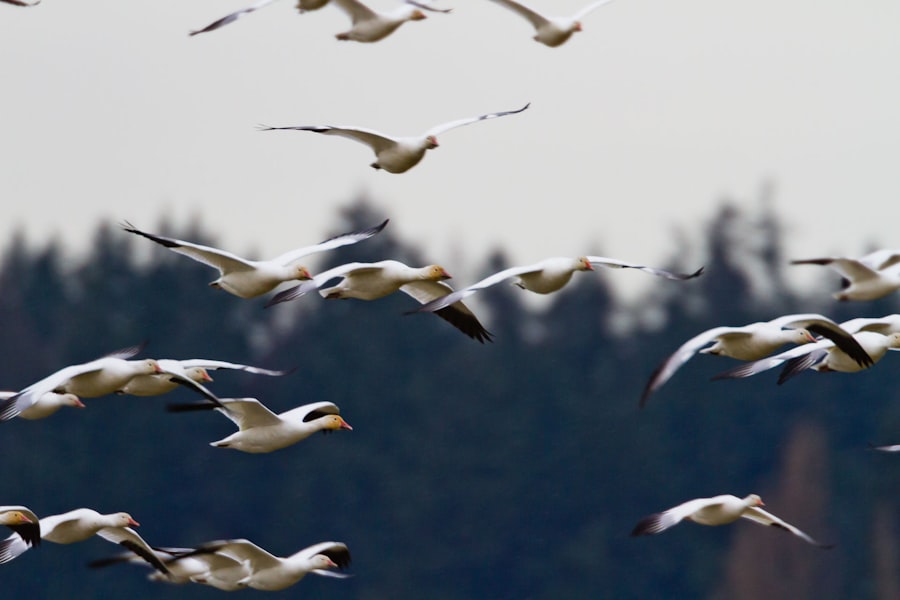
A. Reflective tape
Geese are wary of shiny or reflective objects. Hanging strips of reflective tape near ponds or other areas where geese are a problem can help in deterring them from settling in those areas.
B. Scarecrows
Scarecrows have long been used as a visual deterrent for birds, including geese. Placing scarecrows near ponds or other areas where geese are a problem can help in deterring them from settling in those areas.
C. Balloons
Balloons can also be used as a visual deterrent for geese. Inflating and placing balloons near ponds or other areas where geese are a problem can help in deterring them from settling in those areas.
Chemical repellents for geese
A. Methyl anthranilate
Methyl anthranilate is a chemical compound that is derived from grapes and is known to repel geese. It can be applied to grass or other vegetation to deter geese from feeding in those areas. However, it is important to follow the manufacturer’s instructions and consider the potential impact on other wildlife or nearby residents when using chemical repellents.
B. Capsaicin
Capsaicin is a chemical compound that is derived from chili peppers and is known to repel geese. It can be applied to grass or other vegetation to deter geese from feeding in those areas. However, it is important to follow the manufacturer’s instructions and consider the potential impact on other wildlife or nearby residents when using chemical repellents.
C. Grape extract
Grape extract is another natural repellent for geese. It can be applied to grass or other vegetation to deter geese from feeding in those areas. However, it is important to follow the manufacturer’s instructions and consider the potential impact on other wildlife or nearby residents when using chemical repellents.
Landscaping techniques to discourage geese
A. Removing food sources
One effective landscaping technique to discourage geese is to remove or reduce their access to food sources. This can be done by regularly mowing lawns, removing fallen fruit or seeds, and using bird feeders that are designed to prevent access by larger birds like geese.
B. Creating barriers with plants
Using plants strategically can create barriers that discourage geese from settling in unwanted areas. Planting dense shrubs or tall grasses near ponds or other areas where geese are a problem can make it more difficult for them to access those areas.
C. Adding hardscaping features
Adding hardscaping features, such as rocks or gravel, near ponds or other areas where geese are a problem can make those areas less appealing for nesting or feeding. Geese prefer areas with easy access to water and food, so creating obstacles can help in deterring them from settling in those areas.
Implementing a goose management plan
A. Identifying problem areas
The first step in implementing a goose management plan is to identify the areas where geese are causing problems. This can be done through visual observation, talking to residents or property managers, or consulting with wildlife experts.
B. Setting goals
Once problem areas have been identified, it is important to set goals for managing geese. These goals may include reducing the number of geese in a specific area, preventing geese from nesting or feeding in certain areas, or minimizing damage caused by geese.
C. Creating a timeline
Creating a timeline for implementing and evaluating the effectiveness of different management strategies is crucial. Some strategies may need to be implemented during specific times of the year, such as when geese are nesting or migrating. Regular monitoring and adjustments may be necessary to ensure the success of the management plan.
Encouraging natural predators of geese
A. Hawks
Hawks are natural predators of geese and can help in managing geese populations. Encouraging hawks to nest or roost in an area can help in deterring geese from settling in that area.
B. Foxes
Foxes are also natural predators of geese and can help in managing geese populations. Encouraging foxes to roam freely in an area can help in deterring geese from settling in that area.
C. Coyotes
Coyotes are known to prey on geese and can help in managing geese populations. Encouraging coyotes to roam freely in an area can help in deterring geese from settling in that area.
Seeking professional help to manage geese
A. Hiring a wildlife control company
If geese are causing significant problems and other management strategies have been ineffective, it may be necessary to hire a wildlife control company. These professionals have the knowledge and experience to safely and effectively manage geese populations.
B. Consulting with a landscaper
A landscaper can provide valuable insights and recommendations for managing geese through landscaping techniques. They can help in designing and implementing strategies that are tailored to specific properties or areas.
C. Contacting a local government agency
Local government agencies, such as wildlife or environmental departments, may be able to provide guidance and resources for managing geese. They may have information on local regulations or programs that can assist in managing geese populations.
Managing geese can be a challenging task, but understanding their behavior and implementing effective deterrents can help in preventing problems. From natural deterrents to physical barriers, sound devices to visual deterrents, there are a variety of methods that can be used to manage geese populations. It is important to take action to prevent geese problems, as they can cause damage to property and pose health risks. By sharing this information with others, we can all work together to effectively manage geese and create a more harmonious coexistence with these beautiful creatures.
If you’re looking for effective ways to keep geese off your lawn, you might also be interested in learning how to insulate a chicken coop. Proper insulation not only helps maintain a comfortable environment for your chickens but can also deter unwanted visitors like geese. Poultry Wizard offers a comprehensive guide on how to insulate a chicken coop, providing valuable tips and techniques to ensure your coop is well-protected. Check out their article here for more information on creating a secure and cozy space for your feathered friends.
FAQs
What are some natural ways to keep geese off my lawn?
Some natural ways to keep geese off your lawn include planting tall grasses or shrubs, using decoys of natural predators, and installing motion-activated sprinklers.
What are some non-natural ways to keep geese off my lawn?
Some non-natural ways to keep geese off your lawn include using chemical repellents, installing physical barriers such as fences or netting, and using loud noises or flashing lights.
Why do geese like to come onto my lawn?
Geese are attracted to lawns because they provide easy access to food, water, and shelter. Lawns also provide a clear view of potential predators, allowing geese to quickly escape if necessary.
Are there any risks associated with having geese on my lawn?
Yes, there are several risks associated with having geese on your lawn. Geese can damage your lawn by eating grass and leaving droppings, which can also pose a health risk to humans and pets. Geese can also become aggressive and attack humans, especially during nesting season.
What should I do if I encounter an aggressive goose?
If you encounter an aggressive goose, it is important to remain calm and avoid making direct eye contact. Slowly back away from the goose and try to put an object, such as a tree or car, between you and the goose. If the goose continues to be aggressive, seek help from a professional wildlife control service.
Meet Walter, the feathered-friend fanatic of Florida! Nestled in the sunshine state, Walter struts through life with his feathered companions, clucking his way to happiness. With a coop that’s fancier than a five-star hotel, he’s the Don Juan of the chicken world. When he’s not teaching his hens to do the cha-cha, you’ll find him in a heated debate with his prized rooster, Sir Clucks-a-Lot. Walter’s poultry passion is no yolk; he’s the sunny-side-up guy you never knew you needed in your flock of friends!

